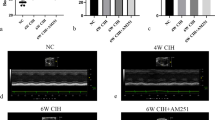Abstract
Cardiac fibroblasts (CFs) participate in cardiac remodeling after hypoxic cardiac damage, and remodeling is thought to be mediated by CF synthesis of brain natriuretic peptide (BNP). It is unknown whether the peroxisome proliferator-activated receptors (PPARs), which mediate cellular signaling for growth and migration, affect BNP synthesis and whether PPARs participate in regulation of extracellular matrix protein (ECM) expression for remodeling. We examined the production of BNP in cultured neonatal ventricular CFs and its signaling system on collagen synthesis and on activation of matrix metalloproteinases (MMPs) in reoxygenation after hypoxia. BNP mRNA was detected in CFs, and a specific BNP protein, BNP1-32, was secreted into the media. Abundance of collagen I and III was increased in the media at reoxygenation. mRNA and protein levels for MMP-2 and the tissue inhibitor of metalloproteinase (TIMP)-1 were enhanced in CFs at reoxygenation. These observations also were noted in CFs after incubation with angiotensin II (10 μM) for 24 h. Pretreatment with pioglitaozone (0.1–10 μM) attenuated BNP mRNA and protein abundance of collagen III, MMP-2, and TIMP-1 in CFs at reoxygenation. The secreted BNP was also decreased by pioglitaozone in the media. Furthermore, PPAR activators inhibited reoxygenation-induced activation of nuclear factor (NF)-kB. These results demonstrate that PPAR activators inhibit BNP synthesis in CFs and imply that PPAR activators may regulate ECM remodeling partially through the NF-kB-mediated pathway.
Similar content being viewed by others
References
Epiner, E. A. (1997) Physiology of natriuretic peptides: cardiovascular function in Natriuretic Peptides in Health and Disease (Samson, W. K. and Levin, E. R. eds.), Totowa, NJ: Humana Press, pp. 123–146.
Cao, L. and Gardner, D. G. (1995) Natriuretic peptides inhibit DNA synthesis in cardiac fibroblasts. Hypertension 25, 227–234.
Tamura, N., Ogawa, Y., Chusho, H., et al. (2000) Cardiac fibrosis in mice lacking brain natriuretic peptide. Proc. Natl. Acad. Sci. USA 97, 4239–4244.
Cameron, V. A., Rademaker, M. T., Ellmers, L. J., Espiner, E. A., Nicholls, M. G., and Richards, A. M. (2000) Atrial (ANP) and brain natriuretic peptide (BNP) expression after myocardial infarction in sheep: ANP is synthesized by fibroblasts infiltrating the infarct. Endocrinology 141, 4690–4697.
Marx, N., Schonbeck, U., Lazar, M. A., et al. (1998) Peroxisome proliferator-activated receptor γ activators inhibit gene expression and migration in human vascular smooth muscle cells. Circ. Res. 83, 1097–1103.
Law, R. E., Goetze, S., Xi, X.-P., et al. (2000) Expression and function of PPAR in rat and human vascular smooth muscle cells. Circulation 101, 1311–1318.
Gralinski, M. R., Rowse, P. E., and Breider, M. A. (1998) Effects of troglitazone and pioglitazone on cytokine-mediated endothelial cell proliferation in vitro. J. Cardiovasc. Pharmacol. 31, 909–913.
Asakawa, M., Takano, H., Nagai, T., et al. (2002) Peroxisome proliferator-activated receptor γ plays a critical role in inhibition of cardiac hypertrophy in vitro and in vivo. Circulation 105, 1240–1246.
Watanabe, K., Sekiya, M., Tsuruoka, T., et al. (1999) Effect of insulin resistance on left ventricular hypertrophy and dysfunction in essential hypertension. J. Hypertens. 17, 1153–1160.
Paternostro, G., Pagano, D., Gnecchi-Ruscone, T., et al. (1999) Insulin resistance in patients with cardiac hypertrophy. Cardiovasc. Res. 42, 246–253.
Tsuruda, T., Jougasaki, M., Boerrigter, G., et al. (2002) Cardiotrophin-1 stimulation of cardiac fibroblast growth: roles for glycoprotein 130/leukemia inhibitory factor receptor and the endothelin type A receptor. Circ. Res. 90, 128–134.
Makino, N., Sugano, M., Masutomo, K., Hata, T., and Fushiki, S. (2003) Matrix degradation enzyme activities on cardiac remodeling in heart failure in Cardiac Remodeling and Failure (Singal, P.K., Dixon, I.M.C., Kirchenbaum, L.A., and Dhalla, N. eds.), Boston: Kluwer Academic Publishers, pp. 305–318.
Yamamoto, K., Ohki, R., Lee, R.T., Ikeda, U., and Shimada, K. (2001) Peroxisome proliferator-activated receptor γ activators inhibit cardiac hypertrophy in cardiac myocytes. Circulation 104, 1670–1675.
Masutomo K., Makino N., Sugano M., Miyamoto S., Hata T., and Yanaga T. (1999) Extracellular matrix regulation in the development of Syrian cardiomyopathic Bio 14.6 and Bio 53.58 hamsters. J. Mol. Cell. Cardiol. 31, 1607–1615.
Sugano, M., Tsuchida, K., and Makino, N. (2004) Intramuscular gene transfer of soluble tumor necrosis factor-α receptor 1 activates vascular endothelial growth factor receptor and accelerates angiogenesis in a rat model of hindlimb ischemia. Circulation 109, 797–802.
Sugano, M., Tsuchida, K., and Makino, N. (2000) High-density lipoproteins protect endothelial cells from tumor necrosis factor-α-induced apoptosis. Biochem. Biophys. Res. Commun. 272, 872–876.
Powell, D. W., Mifflin, R. C., Valentich, J. D., Crowe, S. E., Saada, J. I., and West, A. B. (1999) Myofibroblasts, I: paracrine cells important in health and disease. Am. J. Physiol. 277, C183-C201.
Weber, K. T., Sun, Y., and Katwa, L. C. (1997) Myofibroblasts and local angiotensin II in rat cardiac tissue repair. Int. J. Biochem. Cell Biol. 29, 31–42.
Spinale, F. G. (2002) Matrix metalloproteinases: regulation and dysregulation in the failing heart. Circ. Res. 90, 520–530.
Brew, K., Dinakarpandian, D., and Nagase, H. (2000) Tissue inhibitors of metalloproteinases: evolution, structure and function. Biochim. Biophys. Acta 1477, 267–283.
Tamamori, M., Ito, H., Hiroe, M., Marumo, F., and Hata, R. (1997) Stimulation of collagen synthesis in rat cardiac fibroblasts by exposure to hypoxic culture conditions and suppression of the effect by natriuretic peptides. Cell Biol. Int. 21, 175–180
Schoonjans, K., Staels, B., and Auwerx, J. (1996) The peroxisome proliferator activated receptors (PPARs) and their effects on lipid metabolism and adipocyte differentiation. Biochim. Biophys. Acta 1302, 93–109.
Ricote, M., Li, A. C., Willson, T. M., et al. (1998) The peroxisome proliferator-activated receptor-γ is a negative regulator of macrophage activation. Nature 391, 79–82.
Schoonjans, K., Martin, G., Staels, B., et al. (1997) Peroxisome proliferator-activated receptors, orphans with ligands and functions. Curr. Opin. Lipidol. 8, 159–166.
Jiang, C., Ting, A. T., and Seed, B. (1998) PPAR-γ agonists inhibit production of monocyte inflammatory cytokines. Nature 391, 82–86.
Author information
Authors and Affiliations
Corresponding author
Rights and permissions
About this article
Cite this article
Makino, N., Sugano, M., Satoh, S. et al. Peroxisome proliferator-activated receptor-γ ligands attenuate brain natriuretic peptide production and affect remodeling in cardiac fibroblasts in reoxygenation after hypoxia. Cell Biochem Biophys 44, 65–71 (2006). https://doi.org/10.1385/CBB:44:1:065
Issue Date:
DOI: https://doi.org/10.1385/CBB:44:1:065




